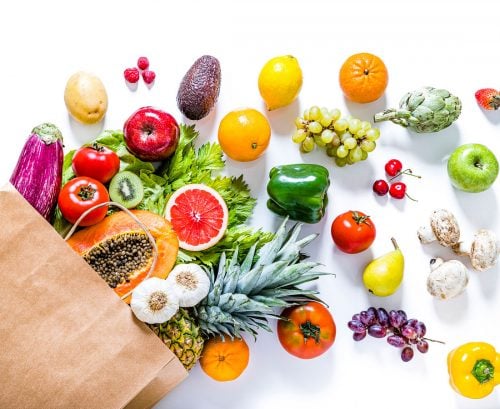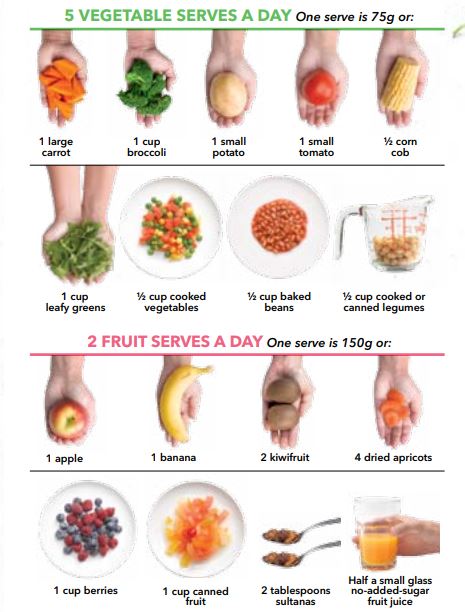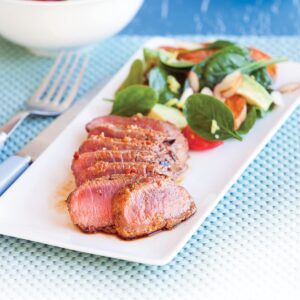
Eat more vegetables and fruit. Yes, we know — we’ve heard it before! But for many of us, our fruit and veg intake is still alarmingly low. Dietitian and Australian HFG editor Brooke Delfino shares 50 ways to make it easier to hit the recommended daily fruit and vegetable targets.
Many of us do want to increase our intake, and also want to help our children eat their greens. But where to start? Read on to discover simple strategies, tricks and tips to hit your five vegetable and two fruit serves each day.
Why you should veg out
There are plenty of reasons to get more fresh food on your plate. Essentially, fruit and vegetables are low in salt, fat and sugar, and high in fibre, vitamins and minerals. Making them your dietary mainstay is an easy way to maintain a healthy weight, and keep your blood pressure and cholesterol in check.
“Increasing the amount of fruit and veggies we eat is one of the simplest ways Australians can improve their health and wellbeing today, as well as combat the growing rates of obesity and lifestyle diseases, such as heart disease, type 2 diabetes and a third of all cancers,” explains Professor Manny Noakes, CSIRO Research Director and co-author of The CSIRO Total Wellbeing Diet. In fact, for every 200 grams of fruit and veg you eat each day, you reduce your risk of developing heart disease by eight per cent and your risk of stroke by 16 per cent.
Variety is the key
No single fruit or vegetable provides all of the nutrients you need to be healthy, so to maximise nutrients and appeal, buy and serve different types. “One simple way to boost your intake is to eat three different types of vegetables with your main evening meal,” advises Professor Noakes.
While the dietary guidelines recommend at least five kinds of vegetables and two types of fruit every day, new research has also shown that people who eat at least 30 different plant foods each week have more varied gut bacteria compared to those who eat less than ten. A more diverse gut microbiome is good news for your overall health.
An easy starting point is to tally up the different plant foods you are currently eating each week, then aim to add an extra three to five plant foods every week until you hit 30. Remember, plant foods include legumes (chickpeas, beans, lentils) as well as whole grains, nuts and seeds.
Write out a shopping list!
To eat more fruit and veg, you need to buy more fruit and veg and, unfortunately, that’s where many of us go wrong. Data show many of us are only buying enough vegetables for 2.3 serves a day, well short of the recommended five or more. Pop some of our fresh ideas (see box below) into your trolley the next time you’re at the supermarket.
How to help a fussy eater
Feeding fussy eaters (big and small) can be frustrating, especially when we all know how full of goodness veggies are. Studies show it can take up to 15 to 20 tastes for your child to appreciate a new flavour. So, as challenging as it is, the key is persistence.
The following strategies can help transform your fussy eater:
Pair new foods with old favourites If your child loves cheese, try grating a little over broccoli florets. Or add pumpkin pieces to their favourite pasta. Gradually increase the vegetable content you add to tried and loved recipes, and see whether anyone notices the difference.
Less is best Serve smaller helpings of new foods. Fussy eaters are more likely to taste and enjoy each component of the meal that way.
Watch your language If you pressure children to eat their vegetables, they may develop the belief that eating them isn’t an enjoyable task.
Make it fun Kids love things on skewers, so experiment with different meat, cheese and veggie combinations. Also, try cutting fruit and vegetables into fun shapes, such as stars or hearts.
Be a good role model Fill your meals with vegetables and demonstrate your enjoyment.
What’s a serve?
Ever wondered what a serve of vegetables actually is? As a guide, one serve of veg weighs about 75g and one serve of fruit is about 150g.
It’s not an exact science — some are easier to ‘measure’ than others — so use this handy visual guide to help you reach your daily targets.

25 ways to eat more veg
- As soon as you buy carrots and celery, chop them into sticks and store in containers to keep in the fridge.
- Try a new veg every week.
- Experiment with different salad dressings made from balsamic vinegar, wholegrain mustard, lemon juice or yoghurt.
- Spread toast or sandwiches with avocado, instead of butter or margarine.
- Store veggies at eye level in the fridge rather than in the crisper.
- Grill broccolini or capsicum slices in a sandwich press between sheets of baking paper.
- Add a layer or two of spinach leaves or silverbeet to lasagne.
- Blend pumpkin into a mac and cheese sauce.
- Add boiled cauliflower, sweet potato or pumpkin to mashed potato.
- Drizzle stir-fried beans or snow peas with olive oil, lemon juice and cracked pepper, or add a shaving of parmesan on top.
- Start the day with a quick mushroom, tomato and spinach omelette.
- Stir baby spinach leaves into cooked risotto, pasta or taco mince.
- Use veggie sticks to snack on homemade guacamole (mashed avocado with diced tomato and red onion).
- Fill capsicums, eggplant or zucchini with leftover savoury mince or bolognese sauce.
- Make a big batch of a veggie-based soup, such as pumpkin or minestrone, and store in individual portions to freeze and reheat for a quick dinner.
- Add diced or grated carrot and mushrooms to bolognese sauce.
- Toss canned chickpeas or lentils into a salad.
- Roast batons of sweet potato and potato to make homemade chips.
- Add cubes of roasted pumpkin, zucchini and eggplant to homemade pizza.
- Swap spaghetti for ‘zoodles’ (zucchini noodles).
- Grate zucchini, carrots or pieces of pumpkin into frittatas and muffins.
- Replace lasagne sheets with grilled strips of zucchini or eggplant.
- Peel and chop pumpkin and sweet potato, then store in the fridge, ready to roast later in the week.
- Turn leftover roasted vegetables into an easy egg frittata.
- Thread pieces of capsicum and red onion in between meat on skewers to barbecue.
25 ways to eat more fruit
- Snack on frozen seedless grapes.
- Snack on apple slices spread with peanut butter.
- Cut up watermelon and store pieces in a container in the fridge.
- Add sliced pears, apples, strawberries, oranges and grapes to salads.
- Make homemade fruit and nut bars with dried fruit.
- Turn overripe bananas into banana muffins or pancakes.
- Top crumpets or raisin toast with sliced banana and strawberries.
- Drizzle muesli and yoghurt with passionfruit pulp.
- Bake pear halves with cinnamon and serve with custard.
- Dip strawberries and cherries into melted dark chocolate.
- Roll a banana in coconut and chop into slices.
- Add sliced mango into rice paper rolls and Asian salads.
- Serve fresh berries with yoghurt for dessert.
- Blend fruit and freeze into popsicle moulds.
- Keep a well-stocked fruit bowl on your kitchen bench or dining table.
- Grate apple into porridge or overnight oats.
- Thread fruit onto skewers to put into kids’ lunchboxes.
- Blend frozen bananas and turn into smoothies.
- Store a bowl of crisp, cold apples at eye level in the fridge.
- Toss a handful of dried fruit or chopped fresh apple through coleslaw.
- Add roughly torn fresh figs to pizza toppings.
- Stir passionfruit pulp into a jug of soda water for a refreshing drink.
- Stew a few stone fruits with a sprinkle of cinnamon and add to porridge or yoghurt.
- Add some fresh blueberries into homemade pancakes and muffins.
- Sandwich Medjool dates with nut butter.
For recipes that provide at least five vegetables serves in one dish check this out.
Fresh ideas for your next veggie shop
- Vegetable-based juices.
- Peeled, pre-cut root vegetables, such as pumpkin and parsnip.
- Bagged salad kits like the Kaleslaw Salad Kit, Thai Style Salad Kit and Rainbow Coleslaw.
- Whole fruits for the lunchbox, such as apples, bananas, mandarins, pears and kiwifruit.
- Vacuum-packed peeled and cooked beetroot.
- Bagged baby spinach leaves and baby rocket.
- Frozen mixed vegetables.
- Frozen berries.
- Asian greens, such as bok choy, choy sum and Chinese broccoli.
- Canned corn.
- Canned legumes, such as four-bean mix, chickpeas and lentils.
- Cauliflower rice.
- Zucchini noodles (‘zoodles’).
- Reduced-salt cans of baked beans.
- Canned fruit or snack-sized fruit cups in natural juice.
- Odd Bunch/Imperfect Picks of fruit and veg.
Article sources and references
- Australian Bureau of Statistics. 2015. National health survey: first results, 2014–15. Accessed May 2021.https://www.abs.gov.au/AUSSTATS/[email protected]/DetailsPage/4364.0.55.0012014-15?OpenDocument
- Australian Bureau of Statistics. 2020. Australians not buying enough fruit or vegetables. Available at www.abs.gov.au Accessed May 2021.https://www.abs.gov.au/articles/australians-not-buying-enough-fruit-or-vegetables
- Better Health Channel. 2011. Fruit and vegetables. Accessed May 2021.https://www.betterhealth.vic.gov.au/health/healthyliving/fruit-and-vegetables
- CSIRO. 2017. Report warns Australian diets lacking in fruit and veg. Accessed May 2021.https://www.csiro.au/en/news/news-releases/2017/diets-lacking-in-fruit-and-vegetables
- Dietitians Australia. 2021. Healthy Eating. Accessed May 2021.https://dietitiansaustralia.org.au/
- Nutrition Australia. 2021. Try for 5. Accessed May 2021.https://www.tryfor5.org.au/
www.healthyfood.com










